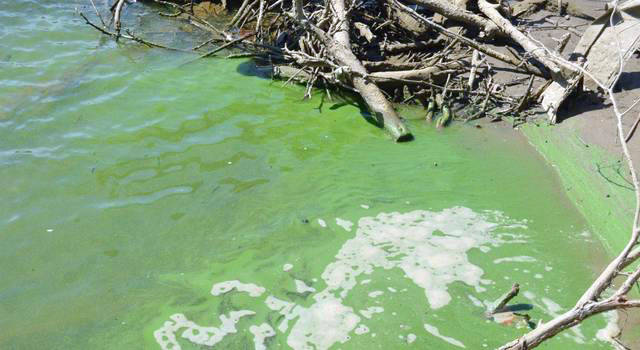By Megan Alley
Champion Media
People and their pets are warned to stay out of the Ohio River, this after harmful algae blooms were found in the waterway near Cincinnati and areas upriver.
Local health officials issued a recreational public health advisory for the Ohio River on Sept. 27.
As of Oct. 1, the river was still under advisory, according to Clermont County Public Health Communications Coordinator Keith Robinson.
HABs, also known as blue green algae, are made up of cyanobacteria that contain chlorophyll and perform photosynthesis. They are known to release toxins that can attack the skin, liver and nervous system in humans and animals.
While many species of blue-green algae do not produce toxins, some species can cause a HAB. Some HABs are visible as thick mats or scum on the surface of the water, and these mats may look like spilled paint and can vary in color, including bluish-green, bright green, or even red or maroon, according to a press release from area health departments, including Clermont County Public Health.
When the levels of microcystin, a class of toxins produced by certain freshwater cyanobacteria, reach six parts per billion, a recreational public health advisory is issued.
Water samples taken by the Ohio River Valley Sanitation Commission on Sept. 26 showed toxins at ‘health advisory’ levels at several locations along the river, including within Clermont, Robinson said.
This recreational public health advisory means that children, pregnant or nursing women, and people with existing medical conditions should stay out of the Ohio River; swimming and wading are not recommended.
Pet owners are also advised to keep their pets out of the river, because if pets get into the water during an algae bloom, they may lick their fur and consume the toxins.
If the weather conditions are right, the algae can spread rapidly, Clermont County Health Commissioner Julianne Nesbit said in a press release.
HABs thrive in warm, calm water with lots of sunlight. They also need access to nutrients, such as nitrogen and phosphorus, which come from the runoff carrying fertilizer applications from farms and lawns.
“These blooms are not uncommon this time of year,” Nesbit said. “Sunny, warm and dry weather is the perfect recipe to create an algae bloom.”
Public water systems have water treatment processes designed to remove toxins if they occur, according to the press release. Drinking water has not been affected at this time, according to Greater Cincinnati Water Works.
The Ohio Environmental Protection Agency, ORANSCO and GCWW are continuing to monitor the Ohio River.
Signs noticing the public health advisory are posted at all the public boat ramps, as well as some campground riverfront campground locations, Robinson said.
According to health officials, people should avoid water that:
— Looks like spilled paint.
— Has surface scums, mats or films.
— Is discolored or has colored streaks.
— Has green globs floating below the surface.
If you or your pet comes into contact with blue-green algae, rinse off with clean, fresh water as soon as possible.
Health officials warn that HABs can produce toxic chemicals that may make people and pets sick depending on the amount and type of exposure, including swallowing HABs-contaminated water, skin contact, and inhaling aerosolized water droplets.
HABs toxins can cause rashes, hives, diarrhea, vomiting, abdominal pain and more severe symptoms at higher levels of exposure.
In some cases, skin irritation will appear after prolonged exposure. If symptoms persist, consult your health care provider.
ORANSCO was set to take another round of samples on Oct. 1, and the results are expected to be available by Oct. 4.
Information will be dispatched when the health advisory is lifted, Robinson said, noting that it will likely be more than a week before it’s entirely safe to return to the river.
At that time, all the warning signs along the riverfront will also be removed.



